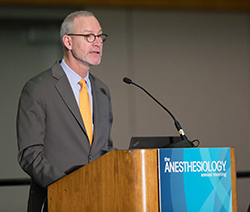
David J. Birnbach, M.D., M.P.H.: ‘Humans make mistakes and we have to improve our communications, and when we work as a team, error rates go down.’
Using large doses of humor and real examples of O.R.-related mistakes, David J. Birnbach, M.D., M.P.H., made the case that health care professionals need to greatly improve communication to reduce errors when he delivered the SOAP/FAER Gertie Marx Plenary Lecture Sunday.
“The take-home message is that humans make mistakes and we have to improve our communications, and when we work as a team, error rates go down. It’s a matter of looking at your system and trying to figure out where the system is putting patients at risk and where you can make the system safer,” Dr. Birnbach said. He is the Miller Professor and Vice Provost at the University of Miami, Senior Associate Dean for Safety, Quality and Risk Prevention, and Director of the University of Miami-Jackson Memorial Hospital Center for Patient Safety at the Miller School of Medicine.
In 1999, the Institute of Medicine (IOM) issued a report that 44,000 to 98,000 people died annually in the U.S. as a result of errors. Data from 2013 and 2014 studies show that more than 200,000 die annually from errors, Dr. Birnbach said. An IOM report released in September said, “Most people will experience at least one diagnostic error in their lifetime, sometimes with devastating consequences.”
Research about dangerous activities gauged risk based on driving a car as being an average risk. “The riskiest activities are bungee jumping, mountain climbing and hospitalization in the U.S.,” Dr. Birnbach said. “They are all about the same mortality rate.”
The problem is that in health care, specialties often work in silos and do not communicate well with one another, he said. That is supported by a study of the root causes of perinatal death and injuries that showed that communication was the top cause, at more than 80 percent, followed by patient assessment, competency/credentialing and leadership.
A study of how well members of O.R. teams knew one another found:
- The anesthesia resident knew the surgery attending 96 percent of the time; the surgery attending never knew the name of the anesthesia resident.
- The anesthesia attending knew the surgery attending — 92 percent; the surgery attending knew the anesthesia attending’s name — 56 percent.
- The anesthesia attending knew the anesthesia resident — 100 percent; the surgery attending knew the surgery resident’s name — 68 percent.
- In less than one-third of cases did any of the anesthesia group correctly identify the name of the circulating nurse.
“In a crisis, you are working in a suboptimal world when you don’t know each other,” Dr. Birnbach said. “It is fuel for bad morale. We can’t be unsung heroes; the anesthesiologists have to be known.”
A solution is for teams to huddle to discuss patients at the shift change, or when there is a change in patient status, key personnel or key staff, he said, but added, “Having the huddle is not as important as paying attention when you have the huddle.”
Dr. Birnbach also called for the use of checklists because, “We all forget at least one of what we consider to be essential parts of a general anesthetic.” In one simulation involving Dr. Birnbach, it took 45 seconds to go through a checklist.
Another option is to use technology, such as wearing a Google Glass to walk through the checklist or call up steps to follow in a crisis situation, he said.
“We need to admit that there is a problem, learn each other’s names, talk to one another, listen, learn to keep cool during crises, and get out of these troubled waters as soon as possible,” Dr. Birnbach said.
